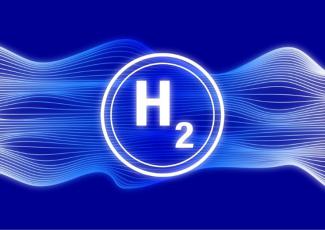NETL researchers have been awarded a patent for a new fiber optic sensor designed to detect hydrogen (H2) leaks at storage facilities that can save time and money compared to traditional methods — progress that can help accelerate the drive to put H2 to work as a dependable fuel to advance America’s decarbonization efforts.
The patented technology, titled “Low-cost Fiber Optic Sensor Array for Simultaneous Detection of Multiple Parameters,” enables H2 monitoring at the parts per million (ppm) level. The H2 leak detection technology features multiple sensing layers along a single fiber for simultaneous H2/gas and temperature sensing. It was originally developed for transformer oil monitoring operations as part of grid modernization efforts.
The sensor array includes nanocomposite thin films along portions of an optical fiber. The NETL technology enables monitoring of multiple sensing points with a single interrogation unit, saving money and time.
NETL, through its research on H2 production, transportation, storage and use, is playing a critical role in U.S. Department of Energy (DOE) efforts to put H2 on the front lines of attaining net-zero carbon emission goals in the power sector by 2035 and the broader economy by 2050, while meeting DOE’s Hydrogen Shot goal of $1 per 1 kilogram in one decade. Monitoring for H2 leaks is important for advancing technologies to take advantage of H2 as a fuel, not only for hydrogen safety but also to access the global warming effect of H2.
At a presentation at the Massachusetts Institute of Technology, NETL Director Brian Anderson, Ph.D., said, “When paired with carbon capture projects, hydrogen power — sourced from our country’s vast fuel resources — presents exciting opportunities to decarbonize power plants and industrial facilities that produce cement, steel and other industrial products.”
According to Ruishu Wright of NETL’s Functional Materials Team, the new patented technology helps answer the call for better innovations to make sure the H2 remains safely stored in underground wells until it is needed to power more of the nation’s critical transportation, electricity generation, and manufacturing applications.
Over the years, many wellbore monitoring tools have been used in geological carbon dioxide (CO2) sequestration by the oil and gas industry and other relevant underground storage industry applications, which can be adopted for hydrogen storage well monitoring. Additionally, there are existing hydrogen sensors such as catalytic combustion sensors, electrochemical sensors, thermo-conductivity sensors, resistive sensors, acoustic leak sensors, and optical based sensors.
“The problem is that existing sensor technologies are mostly point or standoff hydrogen sensors,” Wright said. “There is a real need for wide-area and long-distance monitoring for H2 leak detection in large-scale storage facilities. In addition, the subsurface conditions in some underground storage facilities can be challenging because of higher pressures and temperatures that are not encountered in typical sensor-operating conditions.”
She said NETL’s work has focused on developing more cost-effective approaches for monitoring H2 underground storage facilities over broad areas — capabilities necessary because of the greater mobility and buoyancy of H2 gas plumes.
“Surveillance and monitoring are important for evaluating and managing operational risks of underground hydrogen storage,” Wright said. “Therefore, real-time monitoring is needed to assure storage infrastructure integrity and to detect early signs of gas leakage.”
The new NETL technology enables monitoring of multiple sensing points with a single interrogation unit, saving money and time. Using a similar methodology as in the awarded patent, NETL is developing a variety of optical fiber sensors for real-time monitoring of H2, methane, and chemical parameters at subsurface H2 storage conditions. These advanced sensors will determine microbiological H2 consumption and geochemical pH change and identify well integrity risks.
The work was part of NETL’s participation in a multi-national laboratory effort known as Subsurface Hydrogen Assessment, Storage and Technology Acceleration (SHASTA). The Department of Energy’s (DOE) Office of Fossil Energy and Carbon Management established SHASTA in 2021 to explore H2 storage opportunities in geologic reservoirs.
NETL drives innovation and delivers technological solutions for an environmentally sustainable and prosperous energy future. By using its world-class talent and research facilities, NETL is ensuring affordable, abundant and reliable energy that drives a robust economy and national security, while developing technologies to manage carbon across the full life cycle, enabling environmental sustainability for all Americans.




